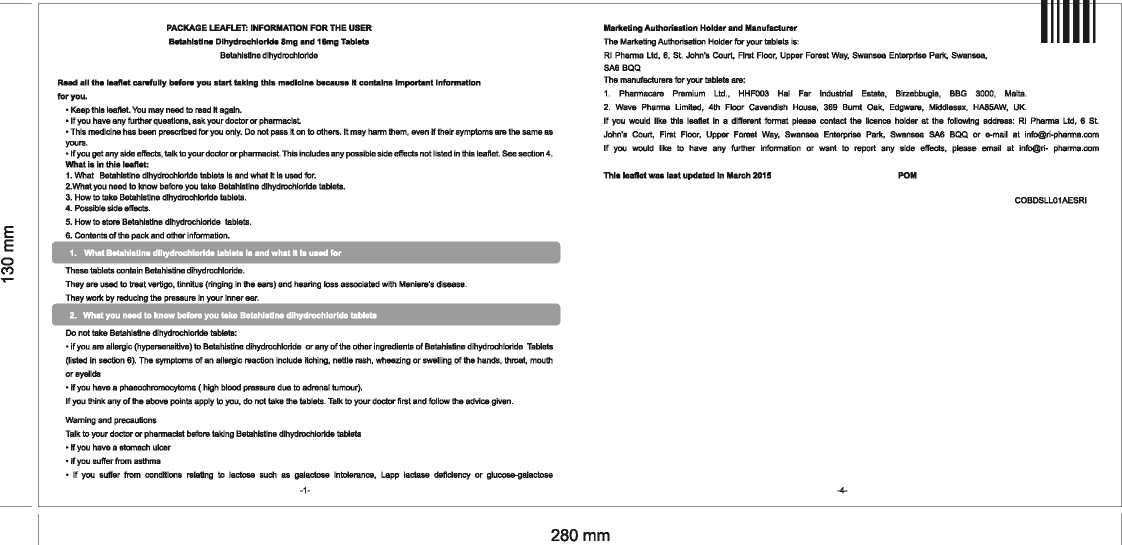Betahistine Dihydrochloride Tablets 8Mg
Date: 17.03.15,19.03.15
Layout No.: 9917630-002 (Hicart)
Pharma code: Front - 205 std.
Back-206 std.
INDOCO REMEDIES LTD.
Packaging Development Department Packaging Material Specification
Item: Leaflet
A/W Code No.: COBDSLL01AESRI Open Size: 280 x 130 mm
Folding Pattern: H-Unfolded: 280 mm Folded: 280 mm W-Jnfolded: 130 mm Folded: 130 mm GSM/Papen 41 gsm ITC superfine / bible paper Colour: Black Approved by:
PDD:_ HOD: _
Reason for Preparation: New Development


E
E
o
CO

Do not store above 30°C, Store In the original package. Do not put them Into another container as they might get mixed up.
Keep out of the reach and sight of children.
Do not use Betahistine dlhydrochlortde tablets after the expiry date which Is stated on the carton.
Medicines should not be disposed of via wastewater or household waste. Ask your pharmacist how to dispose of medicines no longer required. These measures will help to protect the environment.

4. Possible side effects
Like all medicines, these tablets can cause side effects, although not everybody gets them The following serious side effects may occur during treatment with Betahistine:
•Allergic reactions such as: Swelling of your face, lips, tongue or neck. This may cause difficulty breathing. • A red skin rash, inflamed itchy skin
If any of these side effects occur you should stop treatment Immediately and contact your doctor.
Common side effects (may affect up to 1 in 10 people):
Nausea, indigestion and headache
Other side effects
Itching, rash, hives, mild gastric complaints such as vomiting, stomach pain and bloating. Taking Betahistine dihydrochloride tablets with meal can help reduce any stomach problems.
tf any of the side effects gats serious, or If you notice any side effects not listed In this leaflet, tell your doctor or pharmacist Reporting of side effects:
tf you get any side effects, talk to your doctor. This includes any possible side effects not listed in this leaflet. You can also report side effects directly via Yellow Card Scheme at www.mhra.gov.uk/yellowcard.By reporting side effects you can help provide more Information on the safety of this medicine.
B. Contents of the pack and other Information
What Betahistine dihydrochloride tablets contains
The active substance is betahistine dihydrochloride (8mg or 16mg). The other ingredients are lactose, maize starch, microcrystalline cellulose, citric add, crospovidone, povidone and Sodium stearyl fumarate. Betahistine dihydrochloride tablets are gluten free.
What Betahistine dihydrochloride tablets look like and contents of the pack
Betahistine dihydrochloride tablets are round white tablets. The 8mg tablets have R3’ stamped on one side with a scoreline on the other and the 16mg tablets have ‘R4’ stamped on one side with a scoreffne on the other.
Betahistine dihydrochloride 8mg and 16mg tablets are available in packs of 84,100 and 120 Tablets. Not all pack sizes may be marketed.
malabsorption
Other medicines and Betahistine dihydrochloride tablets.
Tell your doctor If you are taking or have recently taken any other medicines, Including medicines obtained without a prescription.
In particular, tell your doctor or pharmacist if you are taking any of the following medicines:
• Antihistamines, which are used to treat allergic conditions.
• Monoamine-oxidase Inhibitors (MAOIs) - used to treat depression or Parkinson's disease. These may Inhibit metabolism of Betahistine Dihydrochloride Pregnancy and breast-feeding
Ask your doctor for advice before taking Betahistine dlhydrochlortde tablet If you are pregnant or planning to become pregnant or you are breast feeding.
Driving and using machines
There Is no Indication that taking Betahistine dlhydrochlortde tablets affects the ability to drive and use machines. However, take care and, If affected, do not drive or operate machines.
Betahistine dihydmchloride tablets contains lactose
These tablets contain lactose which is a type of sugar. Contact your doctor before taking these tablets if you are lactose intolerant.
3. How to take Betahistine dlhydrochlorlde tablets
Always take Betahistine dlhydrochlortde tablets exactly as your doctor has told you.
Check with your doctor or pharmacist If you are not sure.
Swallow the tablets with water and always take with or after meal.
Usual dose for adults and the elderty:
The usual starting dose of Betahistine dlhydrochlortde 16mg three times a day.
After you have been taking treatment for a while your doctor may change the dose to between 24 and 48mg a day.
If you take more Betahistine dihydrochloride tablets than you should
An overdose of this medicine may be dangerous. If you accidentally take too many tablets tell your doctor or go to the nearest hospital casualty department Immediately. The symptoms of a betahistine dlhydrochlorlde tablets overdose are nausea, vomiting, digestion problems, coordination problems and - with higher doses - fits.
If you forget to take Betahistine di hydrochloride tablets
If you forget to take a dose at the right time take It as soon as you remember and If It Is almost time for your next dose, watt until that Is due then go on as before. Do not take a double dose to make up for the forgotten dose.
If you stop taking Betahistine dihydrochloride tablets
Do not stop taking your Betahistine dihydrochloride tablet without talking to your doctor.
If you have any further questions on the use of this product, ask your doctor or pharmacist.
10 mm